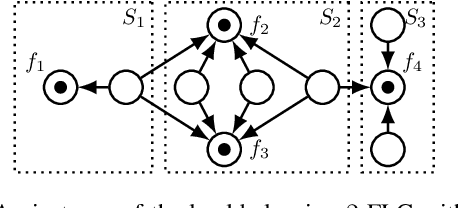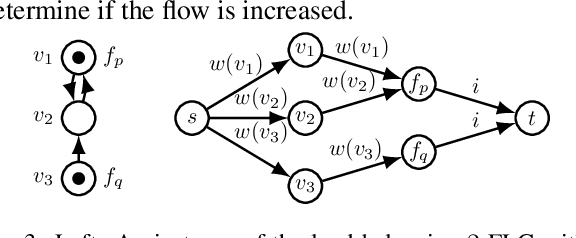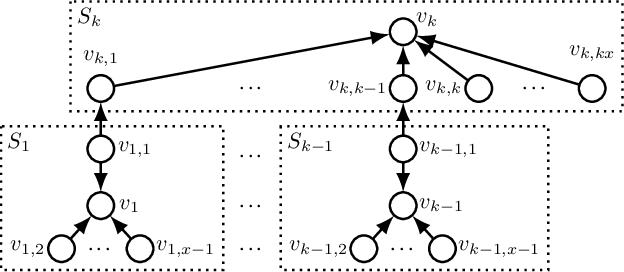Alexander Skopalik
The Bakers and Millers Game with Restricted Locations
Jan 09, 2025Abstract:We study strategic location choice by customers and sellers, termed the Bakers and Millers Game in the literature. In our generalized setting, each miller can freely choose any location for setting up a mill, while each baker is restricted in the choice of location for setting up a bakery. For optimal bargaining power, a baker would like to select a location with many millers to buy flour from and with little competition from other bakers. Likewise, a miller aims for a location with many bakers and few competing millers. Thus, both types of agents choose locations to optimize the ratio of agents of opposite type divided by agents of the same type at their chosen location. Originally raised in the context of Fractional Hedonic Games, the Bakers and Millers Game has applications that range from commerce to product design. We study the impact of location restrictions on the properties of the game. While pure Nash equilibria trivially exist in the setting without location restrictions, we show via a sophisticated, efficient algorithm that even the more challenging restricted setting admits equilibria. Moreover, the computed equilibrium approximates the optimal social welfare by a factor of at most $2\left(\frac{e}{e-1}\right)$. Furthermore, we give tight bounds on the price of anarchy/stability. On the conceptual side, the location choice feature adds a new layer to the standard setting of Hedonic Games, in the sense that agents that select the same location form a coalition. This allows to naturally restrict the possible coalitions that can be formed. With this, our model generalizes simple symmetric Fractional Hedonic Games on complete bipartite valuation graphs and also Hedonic Diversity Games with utilities single-peaked at 0. We believe that this generalization is also a very interesting direction for other types of Hedonic Games.
Equilibria in Two-Stage Facility Location with Atomic Clients
Mar 05, 2024Abstract:We consider competitive facility location as a two-stage multi-agent system with two types of clients. For a given host graph with weighted clients on the vertices, first facility agents strategically select vertices for opening their facilities. Then, the clients strategically select which of the opened facilities in their neighborhood to patronize. Facilities want to attract as much client weight as possible, clients want to minimize congestion on the chosen facility. All recently studied versions of this model assume that clients can split their weight strategically. We consider clients with unsplittable weights, but allow mixed strategies. So clients may randomize over which facility to patronize. Besides modeling a natural client behavior, this subtle change yields drastic changes, e.g., for a given facility placement, qualitatively different client equilibria are possible. As our main result, we show that pure subgame perfect equilibria always exist if all client weights are identical. For this, we use a novel potential function argument, employing a hierarchical classification of the clients and sophisticated rounding in each step. In contrast, for non-identical clients, we show that deciding the existence of even approximately stable states is computationally intractable. On the positive side, we give a tight bound of 2 on the price of anarchy which implies high social welfare of equilibria, if they exist.
Strategic Resource Selection with Homophilic Agents
May 01, 2023Abstract:The strategic selection of resources by selfish agents is a classic research direction, with Resource Selection Games and Congestion Games as prominent examples. In these games, agents select available resources and their utility then depends on the number of agents using the same resources. This implies that there is no distinction between the agents, i.e., they are anonymous. We depart from this very general setting by proposing Resource Selection Games with heterogeneous agents that strive for joint resource usage with similar agents. So, instead of the number of other users of a given resource, our model considers agents with different types and the decisive feature is the fraction of same-type agents among the users. More precisely, similarly to Schelling Games, there is a tolerance threshold $\tau \in [0,1]$ which specifies the agents' desired minimum fraction of same-type agents on a resource. Agents strive to select resources where at least a $\tau$-fraction of those resources' users have the same type as themselves. For $\tau=1$, our model generalizes Hedonic Diversity Games with a peak at $1$. For our general model, we consider the existence and quality of equilibria and the complexity of maximizing social welfare. Additionally, we consider a bounded rationality model, where agents can only estimate the utility of a resource, since they only know the fraction of same-type agents on a given resource, but not the exact numbers. Thus, they cannot know the impact a strategy change would have on a target resource. Interestingly, we show that this type of bounded rationality yields favorable game-theoretic properties and specific equilibria closely approximate equilibria of the full knowledge setting.
Strategic Facility Location with Clients that Minimize Total Waiting Time
Nov 25, 2022Abstract:We study a non-cooperative two-sided facility location game in which facilities and clients behave strategically. This is in contrast to many other facility location games in which clients simply visit their closest facility. Facility agents select a location on a graph to open a facility to attract as much purchasing power as possible, while client agents choose which facilities to patronize by strategically distributing their purchasing power in order to minimize their total waiting time. Here, the waiting time of a facility depends on its received total purchasing power. We show that our client stage is an atomic splittable congestion game, which implies existence, uniqueness and efficient computation of a client equilibrium. Therefore, facility agents can efficiently predict client behavior and make strategic decisions accordingly. Despite that, we prove that subgame perfect equilibria do not exist in all instances of this game and that their existence is NP-hard to decide. On the positive side, we provide a simple and efficient algorithm to compute 3-approximate subgame perfect equilibria.
Two-Stage Facility Location Games with Strategic Clients and Facilities
May 04, 2021



Abstract:We consider non-cooperative facility location games where both facilities and clients act strategically and heavily influence each other. This contrasts established game-theoretic facility location models with non-strategic clients that simply select the closest opened facility. In our model, every facility location has a set of attracted clients and each client has a set of shopping locations and a weight that corresponds to her spending capacity. Facility agents selfishly select a location for opening their facility to maximize the attracted total spending capacity, whereas clients strategically decide how to distribute their spending capacity among the opened facilities in their shopping range. We focus on a natural client behavior similar to classical load balancing: our selfish clients aim for a distribution that minimizes their maximum waiting times for getting serviced, where a facility's waiting time corresponds to its total attracted client weight. We show that subgame perfect equilibria exist and give almost tight constant bounds on the Price of Anarchy and the Price of Stability, which even hold for a broader class of games with arbitrary client behavior. Since facilities and clients influence each other, it is crucial for the facilities to anticipate the selfish clients' behavior when selecting their location. For this, we provide an efficient algorithm that also implies an efficient check for equilibrium. Finally, we show that computing a socially optimal facility placement is NP-hard and that this result holds for all feasible client weight distributions.
 Add to Chrome
Add to Chrome Add to Firefox
Add to Firefox Add to Edge
Add to Edge